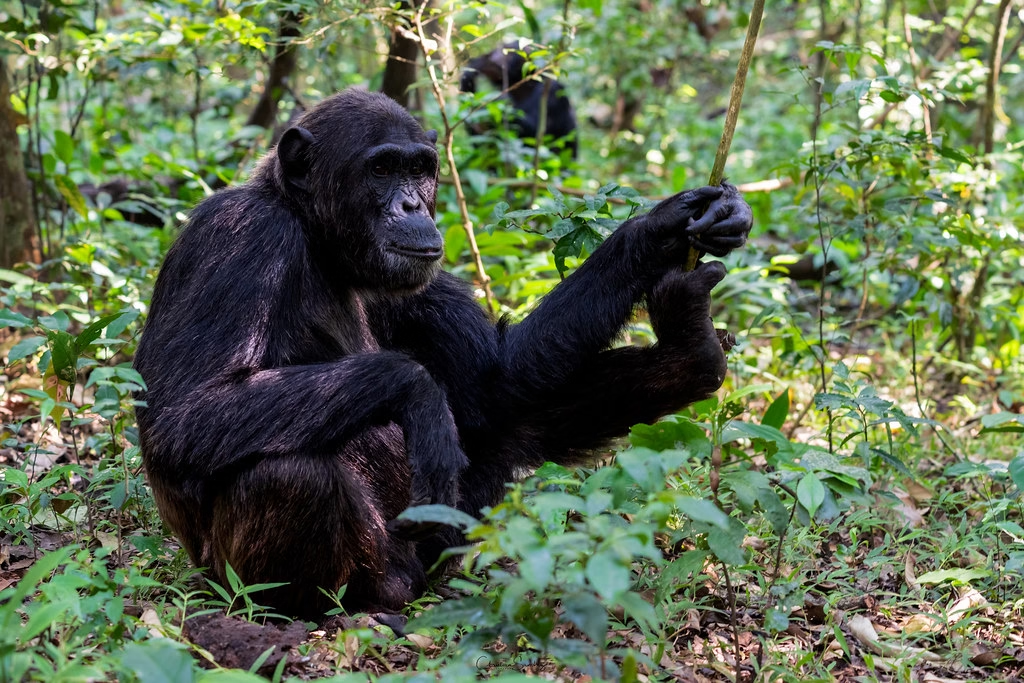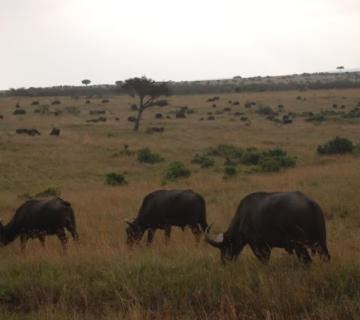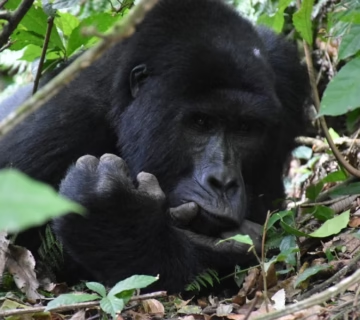Chimpanzee Monitoring and Tracking
tracking chimps
The art of chimps tracking involves walking over the forest to allow one to capture a sight of the amazing primates swinging around the branches.
From the vast underground rain forest in Kyambura Gorge to the wetlands around Kazinga Channel, Queen Elizabeth’s national park boasts five notable habitats.
30km from the loge in Queen Elizabeth national park sits the stunning Kyambura gorge. Found in the eastern side of renowned queen Elizabeth national park, it is also known as the valley of Apes. The gorge, which is drained by river Kyambura and features a near-equatorial rainforest, will present a world different from the one you know. Just enough sunshine reaches the top of the trees. The subterranean flora is strikingly vivid. And if you come to see this gorge, you will not return home the same but rather have something to write about and discuss.
The kind of vegetation in Kyambura Gorge is suitable for the way of life of the well-known chimpanzees; it is distinguished by the towering thick trees and the underground rainforest vegetation. The trees provide seasonally based fruit. The availability of their primary course—fruits—makes the chimpanzee stay a pleasant one.
Compared to other national parks like Kibale, the mobile group of chimpanzees found in Kyambura gorge is rather active. Uganda’s wildlife authority assigned names to more than 24 chimpanzees in July 2013. Once a visitor pays a visit, a tourist has a chance of almost 80% to see the habituated chimpanzees.
Something about the chimpanzees inhabiting Kyambura Gorge in Queen Elizabeth’s national park is unique. Nearly all of them live in Queen Elizabeth national park; so, the chimpazees are acquainted with people and can engage in their activities surrounded by humans. The chimps also live in other places, including Kibale National Park. However, it is by chance that a visitor would find one habituated chimpanzee in Kibale National Park since they are too numerous and mobile in the jungle.
Apart from the trees’ enormous stature and seasonal abundance, their branches are readily twisted. This makes the task of building nests by these chimpanzees simple. The chimps line the tree branches with twigs to create a solid nest and bend the branches to link them.
Not enough, although the gorge boasts numerous habituated chimpanzees for viewing enjoyment. Early in the morning, they swing among the tree branches in search of their meal. Although there are other sites in the kalinzu forest located in Bushenyi, Kibale National Park, queen is amazing for this activity since it has a great variety of wild life, which enhances the chimpanzees to provide you an unforgettable experience.
For what reason should you be a right person to engage in chimpanzee tracking activities?
The cost for chimpanzee tracking in Kyambura gorge is US$ 30 and USHs 30, 000 for the east African community. Still, the chimpanzee monitoring is expected to be done in tandem with a seasoned tour guide. Thus, the professional tour guide receives a payment of US$20 to assist with the habituation of chimpanzees in Kyambo gorge.
The nature of the roads of not just Queen Elizabeth national park but also other national parks, in wet seasons may not be suitable for any kind of vehicles. For monitoring chimpanzees in the national park, a four wheel drive (4WD) is perfect.
For the work of chimpanzee tracking, the morning hours are perfect. Most of the animals are out hunting or from the night movements, such the hippos and others come out to get some sun light like the pythons in nyanzibiri cave in maramagambo forest during the morning hours and especially around 8am.
Chimpanzee tracking in Queen Elizabeth national park is also best done in the morning from 8am, and it lasts for 2-4hrs. By the afternoon, about around 2pm, the game drive is scheduled to take place following activities involving chimpanzees.
The national park boasts a great abundance of vegetation and fauna. Children under the age of fifteen find the practice of chimpanzee tracking less appealing due to this aspect; moreover, they are not allowed to engage in it.
Chimpanzee behavior?
The chimpanzees live in groups known as troops, usually including thirty to eighty members. The big groups consist of small, highly flexible or easily led groups of less chimpanzees, maybe mixed sex or female or male.
The chimpanzees chew on leaves. They chew them then use them as sponge. They sip the moisture by dipping the leaves in water. One might find them beside the Kazinga Channel during the boat ride.
While humans use tools to get food ready to eat, chimps reach there using twigs and sticks. Their twigs are arranged in anthills. This is to make the termites emerge on the twigs unaware they are a chimpanzee’s morning food. For these chimpanzees in Kyambura Gorge, termites provide a delicious feast. They hunt rivals from their nests using the sticks as well.
The chimpanzees search beneath tree roots for nuts as well. The stones let the chimpanzees break the nuts. The chimps lips help them to consume their fruits. They disbranch them off the stems in a fantastic and mouthful style.
The chimpanzees go above ground, among the limbs of a tree. They spend the day terrestrial as well. They climb in the trees late at night to relax following a tough day.
Their walking on the ground with all their limbs renders them quadruped in nature. To assist their tremendous weight, they walk with their fingers half-flexed. They walk straight as well, although this is just temporary. Using their hind limbs—legs—they move short distances.
They climb fast. Attaching on the trees, they use lengthy toes and hands. They so start as first climbers. They line the trees where they nest with twigs and ascend there.
There is no specific mating season for the chimpanzees in any year. Every four to five years the female delivers a baby.
What foods do chimps eat?
Day light creatures (diurnal), the chimpanzees are. Rising early, they search for food. There are roughly eighty different plant items in the chimpanzee diet. The morning breakfast of the chimpanzees consists of fruits. For the chimpanzee community, the fruits constitute their major food. Regarding the fruits they consume, the chimpanzees are rather selective; they only search for the ripest fruits from the trees in the Kyambura Gorge area.
During the wet season, they also eat the leaves, buds, seeds, blooms and blooming. These animals simply eat fresh meat; they are more like humans in that regard. The main entrée is meat; fruits are the accompaniment. Along Nyamunuka Crater Lake, they are seen attacking smaller monkeys as well as flamingo birds. They also hunt for prey, including juvenile antelopes and goats from the surrounding villages.
Before starting chimps’ tracking, what should you know?
- Not walking into the wilderness while unwell. You should not engage in this activity while sick for the love of the environment and protection of wildlife. Human diseases are readily available for chimpanzees.
- Leave the garbage in the park not. The chimpanzees may consume from the polythene bags and experience problems that can cause their mortality. For the preservation of the park, it is therefore advisable to be cautious not to trash there.
- Avoid peeing in the park since it might alter a certain eco system. And if it’s defecating, stay off the path. Then bury your trash under the earth roughly thirty-centimeter depth alongside the toilet paper.
- Never forget to remain silent in the forest. The loudness can frighten chimpanzees among other animals. Remember to keep silent by keeping in mind that “make noise and see no more”.
- You can get in great trouble if you try to imitate the chimpanzees; you might not know what their sign language means.
- One should not eat near the chimpanzees. They might target your fruit or any other meal. Against park regulations, try not to even feed wild animals.
- One should not utilize showy photographs. The broken light and noise from the camera can frighten the chimpanzees.
- They could possibly attack you since you seem to be an enemy.
Other primates identified within Queen Elizabeth National Park
With so many primates like red tailed monkeys, Kyambura Gorge is known as the dramatic gorge; you know, monkeys are really entertaining to watch as they move quickly in the trees.
Among other vervet monkeys, black and white colubus monkeys, and baboons, Kyambura Gorge boasts Given these fascinating and humorous primate populations, it is appropriate for its nicknames, valley of apes, dramatic valley, among others.
Where can you stay when you visit Kyambura Gorge?
When one visits Kyambura Gorge, the accommodation is like a guaranteed bargain; they are distributed around the whole Queen Elizabeth national park. Budget to luxury safari logues and camps; some close to the gorge and others inside the park. Among them are mweya safari logde, katara lodge, king fisher camp, kyambura gorge safari lodge, jacana safari lodge and several others. Therefore, accomodation cannot help you to miss the golden possibility to see the magnificent kyambura gorge for chimpanzee tracking in Queen Elizabeth national park.



